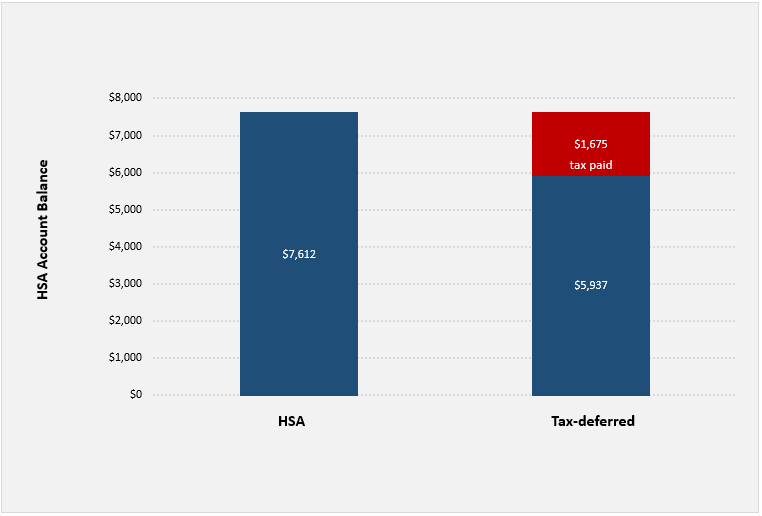You may be familiar with health savings accounts (HSAs) as a way to cover healthcare costs with pre-tax dollars. However, this tax-efficient savings vehicle can also be used as a powerful tool for retirement savings.
An HSA offers triple tax savings,1 where you can contribute pre-tax dollars, pay no taxes on earnings, and withdraw the money tax-free now or in retirement to pay for qualified medical expenses.
That means if you pay qualified medical costs out of an HSA, the money you take out is tax-free.1 You can even use the money you save for nonmedical expenses after age 65 without any penalties. However, you are taxed at ordinary income rates on nonqualified withdrawals, just as you would be with a traditional IRA or 401(k). (If you are under age 65, you pay a 20% penalty on nonmedical withdrawals, and you pay ordinary income tax in addition to the penalty.)
There are a lot of ways to make HSAs work for you—whether you are still employed, getting ready to retire, or even retired and enrolled in Medicare. To get started, consider these 5 ways that HSAs can help fortify your retirement.
1. Understand the triple tax advantage and how HSAs work
You can save in an HSA if you are enrolled in an HSA-eligible health plan at work or in the private and public marketplaces. Most people think of HSAs as a way to save to cover current medical costs not covered by such plans. However, if you can pay for these costs out-of-pocket, the triple tax-free nature of an HSA makes it a powerful vehicle for retirement savings.
Effective January 1, 2026, Bronze and Catastrophic plans will qualify as High Deductible Health Plans, enabling eligible enrollees to open HSAs.
Many people contribute to HSAs pre-tax through payroll deductions at work so their contributions are not subject to FICA taxes. As long as you are enrolled in a health plan that qualifies, you can also open an HSA outside of work and fund it with after-tax dollars, which you then may take as a tax deduction on your personal taxes. These contributions can accumulate tax-free and can be withdrawn tax-free to pay for current and future qualified medical expenses, including those in retirement. If you are no longer covered under a qualifying plan, you can’t continue to make contributions, but you can still hold the account and your previous contributions can continue to grow tax-free.
It gets better: Unlike most flexible spending accounts (FSAs), the money in an HSA can remain in your account from year to year. You can earn interest on earnings with your HSA, and you can even take your HSA with you should you switch employers or retire.
For 2025, the IRS contribution limits for HSAs are $4,300 for individual coverage and $8,550 for family coverage. The HSA contribution limits for 2026 are $4,400 for self-only coverage and $8,750 for family coverage. Any employer contributions will count toward these limits.
If you're 55 or older during the tax year, you may be able to make a catch-up contribution, up to $1,000 per year. Your spouse, if age 55 or older, could also make a catch-up contribution, but will need to open their own HSA. See IRS Publication 969 for more on annual HSA contribution limits.
Because an HSA is one of the most tax-efficient savings options currently available, you may want to consider contributing the maximum allowed and paying for current health care expenses from other sources of personal savings. If you really want the power of HSA compounding to work for you, don't tap into it, unless necessary. Also consider investing a portion of your HSA in a noncash investment option (see section 3) for long-term growth potential.
2. Earmark savings just for health care
You've likely saved for your children's college expenses in a 529 savings account. It's a specialized kind of account that lets you save for a specific expense in your future. You may have also earmarked some of your savings for distinct financial goals such as a new car, a special family vacation, or new home. In each case, your investing goal has a different time horizon and should be handled in a different way.
Now think about health care. You'll likely face a bevy of health care expenses in your future—medical procedures, hospital bills, prescription drugs, maybe even home health care or nursing home expenses. No one knows when these expenses will hit, or how much you may have to pay.
Since you will likely have to pay for large scale health care expenses sometime later in life, building a nest egg specifically designed to help cover future health care costs is a prudent move. How much should you save?
On average, according to the 2025 Fidelity Retiree Health Care Cost Estimate, a 65-year-old individual may need $172,500 in after-tax savings to cover health care expenses in retirement.
Even if you don't have an HSA, it may be prudent to set aside certain assets just to pay for health care. "Health care will likely be one of your top 5 expenses in retirement," says Steven Feinschreiber, Senior Vice President of Financial Solutions at Fidelity. "So consider earmarking a portion of your 401(K) or IRA along with HSA to help pay for expected health care costs throughout your retirement."
Tip: Not all health care expenses count as "qualified medical expenses" according to the IRS. Find out which ones you can use your HSA for. Read IRS Publication 502 Medical and Dental Expenses to learn more.
3. Consider putting your HSA dollars to work by investing them
Although health care costs continue to rise, there are ways to get ready for medical expenses that might come in retirement. However, you’ve got to save early and put those dollars to work by investing them.
If you think you might need to use some of your HSA for near-term medical expenses, set aside some of your HSA in cash to cover them, and invest the rest for potential tax-free growth and to help fortify your retirement.
"You have several options when thinking about how to put your HSA dollars to work by investing them," advises Feinschreiber. "Some people choose an investing strategy that is less aggressive than their overall retirement investing strategy," he adds. Work with a financial professional to determine an investment strategy that makes sense for you.
Tip: Once you establish a cash cushion within your HSA to pay for short-term unanticipated qualified medical expenses and out-of-pocket maximum deductible limits, you may have a large enough account balance to begin investing. If you’re interested in investing your HSA dollars, Fidelity makes it easy with 2 HSA options—you can choose the self-directed Fidelity HSA® to manage your own investments or the Fidelity Go® HSA to enjoy the benefits of professional money management. Learn more.
How do HSAs compare to other savings vehicles? The tax treatment of HSAs provides the potential for greater investment growth and greater after-tax balance accumulation versus other retirement or health care savings options. Assuming you use HSA funds to pay for qualified medical expenses, you do not pay any federal taxes. That's why it's at the top of the list for tax-efficient investment options for your retirement. In this hypothetical example, a customer invests $1,000 in their HSA.
Over the next 30 years, that single investment of $1,000 grows at 7% a year to $7,612. If that HSA account holder invested the same $1,000 in a tax-deferred account like a traditional IRA, their total investment return would also be $7,612. Of that amount, only $5,937 remains after paying income taxes at an effective rate of 22% upon distribution.
Tax-deferred growth versus HSAs

4. Plan to use your HSA in retirement
While you can’t pay premiums for all types of health insurance coverage using HSA money, you can use HSA funds to pay for qualified medical expenses such as deductible, copay, and coinsurance:2
1. Help bridge to Medicare If you retired prior to age 65, you may still need health care coverage to help you bridge the gap to Medicare eligibility at 65. Generally, HSAs cannot be used to pay private health insurance premiums, but there are some exceptions, such as paying for health care coverage purchased through an employer-sponsored plan under COBRA and paying premiums while receiving unemployment compensation.
Retiring before 65? Explore health insurance options and estimate potential costs before you’re Medicare-eligible.2. Cover Medicare premiums You can use your HSA to pay certain Medicare expenses, including premiums for Part A (if applicable), Part B and Part D prescription-drug coverage and Medicare Advantage, but not supplemental (Medigap) policy premiums. For retirees over age 65 who have employer-sponsored health coverage, an HSA can be used to pay your share of those costs as well.
3. Long-term care expenses Your HSA can be used to cover part of the cost for a "tax-qualified" long-term care insurance policy. You can do this at any age, but the amount you can use increases as you get older.
4. Pay for other expenses Once you hit 65, you can use your HSA to pay for any nonqualified medical expenses (including buying a boat, for example), but you don't get to take full advantage of the tax savings as you will be required to pay state and federal taxes on those distributions.
5. Let HSAs play a role in your estate plan
In the event that your medical expenses are much lower than average (or you don't live that long), you may have money in your HSA that you can pass along to your heirs. The rules are complicated so it's best to consult your estate planning attorney. There are generally 3 categories to consider when determining how HSA assets are treated upon your death:
1. Spouse is the designated beneficiary If your spouse is the designated beneficiary of your HSA, it will be treated as your spouse's HSA after your death with the same triple-tax-free treatment.
2. Spouse is not the designated beneficiary If your spouse isn't the designated beneficiary of your HSA, the account stops being an HSA, and the fair market value of the HSA becomes taxable to the beneficiary in the year in which you die.
3. Your estate is the beneficiary The fair market value of the HSA is included on your final income tax return.
Of the options listed, many people would prefer to name the surviving spouse as the designated beneficiary. However, if you don't have a surviving spouse, a planning consideration could be tax-efficiency. In that case, consider naming as beneficiary (either your estate or beneficiary), whichever party is in the lowest tax bracket. Work with your tax and estate planning professionals to determine which option is right for you.
Tip: One caveat: If you name your estate as the beneficiary of your HSA, it will likely become a probate asset and it still needs to fit in with your overall estate plan.
Plan ahead
Typically, once you turn 73, you will need to take required minimum distributions from traditional IRAs and 401(k)s, and you would have to pay taxes on those distributions. For HSAs, there is no required minimum distribution.
Since an HSA offers a triple-tax advantage, it's an option you should consider prioritizing to fortify your retirement now and for years to come.



